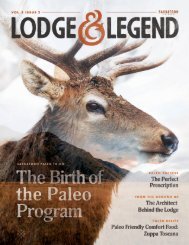Create successful ePaper yourself
Turn your PDF publications into a flip-book with our unique Google optimized e-Paper software.
PARTNER SPOTLIGHT<br />
In addition to the potager gardens that both decorate the<br />
common spaces around the restaurant, as well as feed<br />
its patrons, Chris wanted to create a more defined space<br />
simply for gardening for the restaurants. So, behind the<br />
restaurant (all along the area’s future Swamp Rabbit<br />
Trail), he installed 50-foot rows filled with all the veggies<br />
commonly used in Saskatoon’s dishes <strong>and</strong> Paleo meals—<br />
effectively furnishing the restaurant with a large portion of<br />
their needed produce.<br />
“The biggest challenge is to grow the quantity that they<br />
need, but also to have enough diversity to give them<br />
options. And it is a big challenge as the restaurant sales are<br />
multiplying every day!” Chris says.<br />
“I can’t say enough great things about the Woos…it’s<br />
been great to work with them <strong>and</strong> to get to help them with<br />
their overall vision which has been really cool, <strong>and</strong> there<br />
is a true community aspect of growing food that they get.”<br />
Chris says. “It’s this thing that used to be so commonplace<br />
<strong>and</strong> people used to grow their own food, <strong>and</strong> that’s<br />
been lost—especially in younger generations, with mine<br />
included. I thought what I do would be a unique service<br />
<strong>and</strong> maybe I can be a catalyst for that—or maybe when the<br />
bugs come <strong>and</strong> the weeds I can just be added elbow grease.”<br />
Working alongside Edmund <strong>and</strong> his team in the development<br />
was a great opportunity, but Chris notes that the lodge’s<br />
completion didn’t release him from the grounds. In fact, he’s<br />
remained engaged the entire time, watching gardens, <strong>and</strong><br />
replanting as needed for different seasons.<br />
As each season changes, so do the plants growing at<br />
Saskatoon. After the summer ends, he’ll pull out basil <strong>and</strong><br />
other summer plants, to replace them with kale, collards<br />
<strong>and</strong> other vegetation that loves the cold weather. In the<br />
potagers, he’ll replace annuals with perennials that will<br />
come back year after year, <strong>and</strong> add more herbs for the<br />
kitchen, as well as lavender, rudbeckia (which brings along<br />
beneficial insects), <strong>and</strong> snapdragons <strong>and</strong> violets.<br />
The goal is to produce four different seasons of interest<br />
<strong>and</strong> functionality within the outdoor spaces, <strong>and</strong> ideally<br />
produce around three to seven crops per row over the<br />
course of the year to yield the highest amount of produce.<br />
So far, he’s close. “For a production garden we’re right<br />
around a quarter of an acre (with plans to grow to at least<br />
an acre or so), so I have to be smart with what I grow in<br />
terms of days to maturity,” he says. “I’ve already grown<br />
four or five crops in one of those beds since July.”<br />
While Chris has loved working with the team at Saskatoon,<br />
Chris notes that his heart is truly in helping others<br />
underst<strong>and</strong> the connection between farming <strong>and</strong> food in a<br />
way that is up close <strong>and</strong> personal.<br />
People used to grow<br />
their own food, <strong>and</strong><br />
that's been lost.<br />
CHRIS MILLER<br />
9




